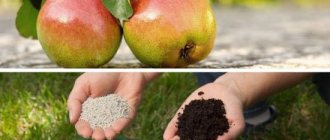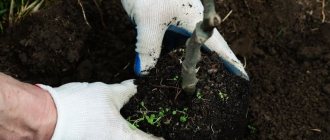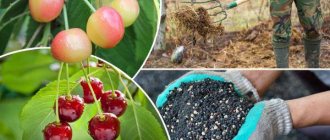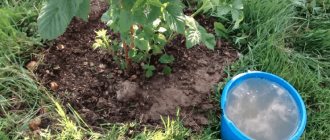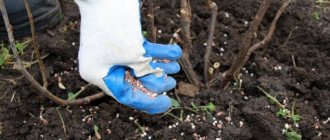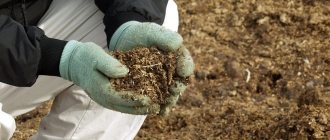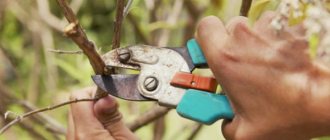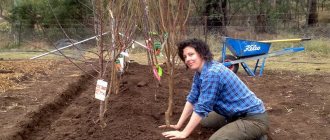In order to harvest a rich harvest of juicy, ripe apples in the fall, you need to take care of the trees all year round. Just as people and animals need food, fruit trees need periodic feeding. Watering alone is not enough for the plant to reserve strength for the birth of a harvest. Minerals and elements that are lacking in the soil are needed. There is a very popular proverb among gardeners: “There is no bad land - there are bad owners.”
Fruit trees
Fertilizers for apple and pear trees must be chosen carefully and thoughtfully. The health of a plant can be affected not only by a deficiency of nutrients and minerals, but also by their excess. Gardeners often overdo it, filling the soil around apple trees with humus and filling it with mineral fertilizers. A plant can “get sick” and stop bearing fruit if there is a lack of just one or two of all the necessary microelements.
Types of fertilizers and principles of their application
For full development and abundant fruiting, fruit crops must be fed with a complex of macro- and microelements. The most important of them include:
- Phosphorus – stimulates the growth of the root system and helps strengthen it. In addition, it increases the number of flowers and ovaries on trees.
- Nitrogen – promotes the growth of green mass.
- Potassium – strengthens the immune system, increases winter hardiness, which has a beneficial effect on yield.
Preparations that contain the listed elements can be of two types - organic and inorganic. Organics are represented by:
- bird droppings;
- green manure;
- slurry;
- peat mixtures;
- humus.
Experienced gardeners use compost prepared from various plant wastes as organic fertilizer.
The following inorganic compounds are distinguished:
- potassium (potassium or its salts are especially preferable for fruit trees);
- nitrogen - ammonium nitrate, urea, ammonium sulfate;
- phosphorus – superphosphates;
- complex compositions containing phosphorus, potassium and nitrogen in different proportions - ammophos, nitroammophosphate, nitrophos, etc.
Store-bought bird droppings contain a large amount of nitrogen, so overuse of this fertilizer can negatively affect the condition of the tree's root system.
In the process of spring fertilizing, the annual norm of nitrogen and 2/3 of its part of phosphorus and potassium are added to the soil. In summer, the use of nitrogen promotes excessive growth of green mass, which reduces yield and frost resistance. In addition, summer fertilizing with nitrogen increases the nitrate content in fruits.
Preparations with the maximum amount of phosphorus and potassium remove the accumulated nitrogen compounds from trees in a short time.
Phosphorus and potassium fertilizers are most suitable for application to the soil in summer and autumn. Using them in large quantities in the spring is extremely undesirable due to the high risk of diseases of apple and pear trees.
When choosing spring fertilizing, it is necessary to take into account the type of soil, for example:
- for sandy and sandy loam - nitrogen compounds, compost, humus, mullein;
- for clay and loam - alternating potassium and phosphorus compositions in moderate quantities;
- for limestone - organic matter and potassium preparations.
Since chernozem contains nitrogen in sufficient quantities, its additional application is not necessary. To loosen this type of soil, sawdust or sand is used. You can also add peat, but in limited quantities so as not to exceed the acidity of the soil.
It is recommended to add dolomite or bone meal to acidified soil; spring is best suited for this procedure.
Why fertilize an apple tree in the spring: why do you need spring feeding?
In spring, the apple tree especially needs complex nutrition such as nitrogen, potassium, magnesium, phosphorus, iron, zinc, etc.
Nitrogen is responsible for the active growth of the crown and green mass of the plant.
Important! An excess of this element is unacceptable, so it is used only in the spring (before flowering, at the beginning of the fruit growth phase).
Phosphorus is needed to strengthen the root system. The beginning of a tree's growing season largely depends on phosphorus nutrition. This substance also helps the apple tree during the period of flowering and the formation of good ovaries and high-quality fruits. In spring, phosphorus and potassium fertilizers must be applied before the beginning of the growing season and during the flowering period. They also feed the apple tree in the fall after harvesting.
Potassium promotes proper carbohydrate metabolism and is involved in accelerated ripening of fruits. Like phosphorus, it has a positive effect on the tree’s immunity and increases its resistance to winter frosts and dry summer weather.
Important! Fertilizers that contain potassium and phosphorus help quickly process nitrogen nitrates.
Recommended standards
When using mineral concentrates purchased in a store, you must strictly adhere to the dosages placed on the packaging by the manufacturers. The norm for organic compounds is from 3 to 8 kg per 1 m2 of tree trunk circle, taking into account the type of soil and age of the fruit crop. Liquid fertilizers are applied in 3-4 buckets under each trunk.
If there are any doubts about the amount of fertilizing applied, then it would be better to reduce the norm than to exceed it, since an excess of drugs leads to burns of the root system and tree diseases.
What to consider when feeding fruit trees
Plants, like all living things, need care: feeding, pruning, treatment. But you cannot act according to the same scheme in different periods, with different cultures, in different natural conditions. When choosing the optimal method of fertilizing garden trees, consider:
- type and age of the fruit tree (in our case, an apple or pear tree);
- soil type (clayey, sandy, sandy loam, loamy, calcareous, peat, black earth);
- soil condition (structure, moisture capacity, pollution, fertility, depletion),
- climatic conditions (average annual temperatures, precipitation);
- type of fertilizer (organic, mineral, microelements);
- last feeding (when and what was fed, how and in what quantity were fertilizers applied).
Further, it is necessary to diagnose the lack of fertilizers (by the appearance of the tree and the nature of the soil) and a fertilizing plan, since different types of fertilizers are not applied at the same time or in different ways.
Fertilizer application algorithm
Fertilizing apple and pear trees must be done throughout the growing season. Nutrients can be “delivered” to trees using both root and non-root methods.
in spring
The first feeding is carried out on bare branches - before the appearance of a green cone, as a rule, this happens in March, after the snow has melted and the trees have awakened. At this time, mainly nitrogen-containing preparations are applied to the roots, stimulating the launch of the vegetative mechanism of trees.
Before flowering
Usually the following are used as early fertilizers:
- ammonium nitrate - when working with the preparation, take into account the age of the garden: to feed 1 adult tree, 40 g of the substance are diluted in 10 liters of water, for a young specimen - 20 g;
- potassium sulfate - regardless of the age of fruit crops, diluted with water in a ratio of 5 g per 5 l;
- ammonium sulfate - if this fertilizer is used simultaneously with other nitrogen-containing compounds, then 15 g of it will be needed for 5 liters of water; if the drug acts as the main fertilizer, then 25 g of powder will be required for every 5 liters.
During the loosening process, flavoring solutions are added to the soil.
During flowering
During the flowering period of the garden, mixtures containing nitrogen are used for feeding. The most common options include (dosage is calculated for one tree):
- urea – 600 g;
- nitroammophoska or ammonium nitrate – 40 g;
- humus - 5-6 buckets.
Each of them is brought into the tree trunk circle during the process of digging along the perimeter of the crown.
After flowering
During the period of fruit ripening, garden crops are fed with one of the following liquid products:
- sodium humate and nitrophoska diluted with water;
- composition of potassium sulfate (70 g) and superphosphate (100 g);
- chicken manure (2 l);
- slurry (1/2 bucket);
- urea (300 g).
More than 3 buckets of liquid must be added under each tree. Partial replacement of root feeding with foliar feeding is acceptable. In this case, it will be quite enough to use urea.
Foliar feeding is carried out after the final formation of a green cone; The drug absorbed by the leaves enters the root system over time.
In summer
During the flowering period, fruit crops take a large amount of nutrients from the soil, so at the end of this phase the trees need feeding.
The first summer feeding is carried out 14 days after the flowers fall. Usually this procedure falls on the 1st or 2nd decade of June. At the early stage of fruit formation, potassium, nitrogen and phosphorus are added to the soil. Organic matter is used as a source of nitrogen - chicken manure or manure aged for at least 4 months.
Manure is diluted with water in a ratio of 1:6 and the mixture is poured onto the tree trunks of apple and pear trees.
Before adding liquid manure to the soil, you must first pour 20 to 40 liters (depending on age) of ordinary water under the trunk of each tree.
Mullein consumption is as follows:
- for trees under 5 years old – 10 l;
- for adult specimens – 20 l.
The dosage of bird droppings diluted with water in a ratio of 1:12 is as follows:
- for young crops - 5 l;
- for an adult – 10 l.
The rate of potassium and phosphorus fertilizers applied after the flowering period is 10 g of both types for each year of life, but the total dose should not exceed 100 g.
The second summer feeding is carried out 20 days after the first . It usually falls at the end of June or the first days of July. At this time, apple and pear trees no longer need nitrogen and organic matter: during the process of fruit ripening, trees require potassium and phosphorus. Fertilizers are applied after abundant watering, adhering to the following rule:
- phosphorus compounds - 15 g for each year of the crop’s life, but not more than 150 g;
- potash - 10 g (but not more than 100 g per barrel).
During the second feeding, in addition to potassium and phosphorus, calcium nitrate, diluted with water in a ratio of 35 g per 10 liters, is added to the soil.
The third feeding is carried out at the end of July or beginning of August. For this purpose, calcium, phosphorus and potassium are used. Fertilizers are applied no later than 20 days before harvest.
in autumn
Every year in September, 30 g of potassium sulfate is added per 1 m2 of tree trunk circle.
Also at this time, complex autumn fertilizer is relevant, the consumption rate of which is indicated on the packaging. Preparations applied in the fall should not contain nitrogen, since the purpose of fertilizing is to prepare the trees for winter.
Despite the fact that in October the orchard no longer needs fertilizing, watering followed by mulching at this time is very important. Compost or humus is used as mulch: in the spring, these substances provide additional nutrition for the trees.
Ready-made fertilizers for apple trees, including quickly digestible and chelated ones
Some summer residents have limited time for gardening. In this case, you can use ready-made fertilizers, which can be purchased in specialized stores. There are many complex fertilizers for fruit trees, including apple trees. They contain all the nutrients for the proper development of the tree and the creation of a good fruit harvest.
- Gumi-Omi "Fruit trees and shrubs". The fertilizer is based on chicken manure. You can note long-acting drugs with a granular release form, for example, “Spring” from Fusco. It is recommended to apply them dry around the perimeter of the tree and then water well.
- Aquarin “Fruit and Berry” , which is produced by. The preparation containing quickly digestible microelements is applied during the period when the apple tree begins to bloom. Also, Aquarin can be used to feed a tree using the foliar method.
- Plantafide from Agromaster . The drug, containing substances in chelated form, is quickly absorbed by the plant. Recommended for foliar treatment of apple trees in any growing season if necessary.
- Hera "Orchard" and others.
Feeding methods
To give trees the opportunity to fully absorb nutrients, they must be applied correctly. Typically, root and foliar feeding alternate with each other.
Application under the roots
This method involves applying fertilizers to the soil in a circle near the trunk, while the cultivated area exceeds the diameter of the crown by 2 m. Dry and liquid formulations are used to carry out the activity.
Liquid
Liquid preparations are introduced into a previously prepared circular furrow with a depth of up to 40 cm and a width of 30 cm. To feed dwarf breeds, ditches are made with a shallower depth.
This method cannot be used for columnar trees, since their roots are located too close to the surface and will be damaged when digging a furrow.
Also, liquid compositions can be poured into dug wells with a depth of 50 cm. To perform them, use a crowbar or a drill; there are 2-3 such holes per 1 m2 of tree trunk circle. Before using nutritional preparations, it is advisable to dissolve dry fertilizer granules in warm water in advance so that they do not remain in sediment.
Dry
1-2 hours before adding nutrients to the soil, abundant watering is carried out, and only after this the fertilizers are scattered in the tree trunk circle. In dry weather, after this procedure, watering is repeated.
When using ammonium nitrate, add it slightly dropwise, otherwise when it comes into contact with air, this substance loses some of its nitrogen. To ensure that the soil completely absorbs the fertilizer, it is regularly loosened.
Foliar method
This method is used as an additional one.
As a rule, it is relevant when the fruit crop suffers from a deficiency of any elements. Foliar feeding is carried out after the formation of green mass. For spraying, choose dry and windless weather. To avoid burning the leaves, it is recommended to carry out the procedure early in the morning or in the evening after 20:00. During the day, such an event is only permissible in cloudy weather, when no rain is expected. Typically, foliar feeding is carried out using ash dissolved in water in a ratio of 250 ml per 10 l, or urea - 30 g per 10 l. These compounds strengthen trees and at the same time destroy harmful insects. They also use ready-made drugs purchased in the store, for example:
- "Plantafide";
- "Aquarin";
- "Agromaster".
Basic rules and recommendations for spring fertilization of apple trees
A young tree that was planted in a permanent place last year does not need to be fertilized in the spring. The fact is that during planting of the seedling, according to the rules, all the nutrients in the required quantity were already placed in the hole.
Watch the video! Fertilizing the apple tree in spring
Fertilizing the apple tree is carried out only after 2-3 years, since by this time the land is depleted and nutrition becomes insufficient.
Important! Before applying liquid fertilizer to the apple tree, it must be well watered. This can be done a day or a couple of hours before feeding.
Important! Especially watering should be done before applying mineral fertilizers. In this way, you can protect the root system from burns.
If, while applying fertilizer to the roots, it accidentally gets on the fruits or leaves, you need to spray them with water to wash off the mixture. The fact is that it contains a much higher concentration of nutrients (2-3 times) than with the foliar method of fertilizing.
The plant is fed in the early morning or evening, when the sun's rays are not so strong. You can also fertilize on a cloudy day.
Advice! It is better to dissolve mineral fertilizers in the form of granules, especially superphosphate, in a container of hot water in advance. In cold water, the crystals will dissolve too slowly and not completely.
Principles of feeding for different ages
If during planting all the necessary nutritional elements were added to the seedling hole, no feeding is required for the first 3 years. It will be quite enough to use drugs to stimulate the growth and development of roots, for example “Kornevin”. In addition, it is permissible to feed trees with phosphorus, but you should avoid adding nitrogen-containing compounds at this time.
At the age of 15 years, apple and pear trees need additional feeding, even when growing on fertile soil.
Feeding the seedling after planting
Immediately after planting, care consists of systematic watering, loosening the soil and weeding. It is recommended, as long as there is no strong shading from the crown of a young tree, to grow green manure and then incorporate them into the soil. Mustard and buckwheat are good for this. Clay and sandy soils must be dug up and organic matter added. The tree trunk circle should be regularly tied with humus or compost, thereby improving the soil structure and enriching it with nutrients. Calcareous soils are favorably affected by the application of potassium fertilizers.
Possible consequences of excess nutrients
As a result of the resulting excess fertilizer applied, the risk of developing a problem such as bitter pitting of fruits, associated with calcium deficiency in the pulp of pears and apples, increases. As a rule, this disease develops due to the high content of magnesium, potassium and nitrogen in the soil. The lesion is observed during fruit ripening or in the first few weeks after harvest.
The problem can be prevented by strictly following fertilizing in the spring, taking into account the composition of the soil. If necessary, the frequency and rate of medications applied is reduced. Spraying the leaves with the following compounds will also help reduce the likelihood of disease:
- calcium nitrate;
- chelate preparation "KompleMet-SA";
- calcium chloride.
With proper application of fertilizers in compliance with the regime and standards, apple and pear trees will delight you with their abundant and high-quality harvest for many years.
Previous
Tree care
